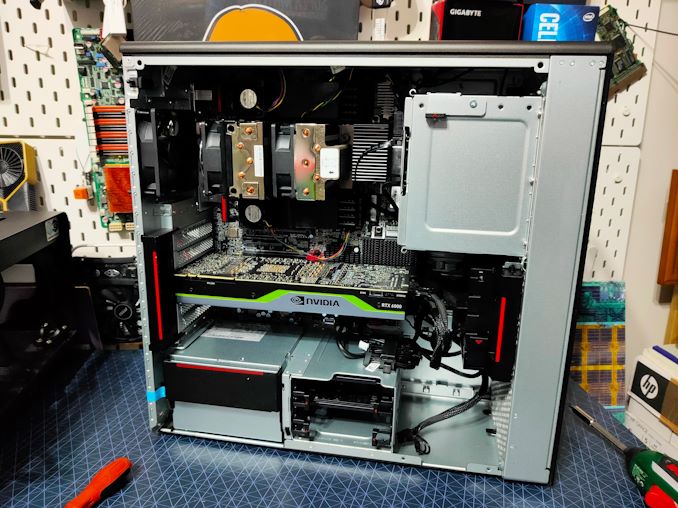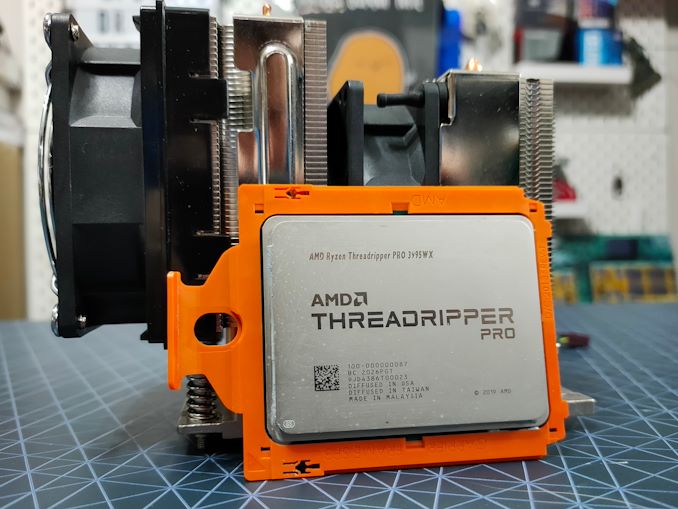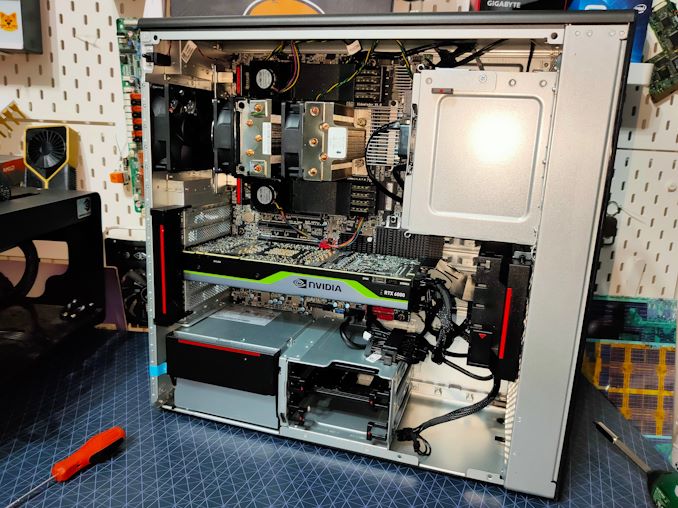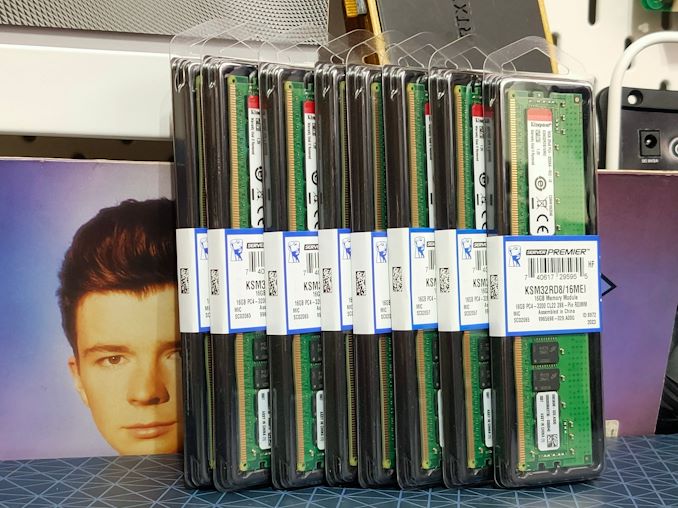Lenovo ThinkStation P620 Review: A Vehicle for Threadripper Pro
by Dr. Ian Cutress on February 16, 2021 9:30 AM EST
The workstation line of machines from Lenovo have been extremely successful for the company. While ThinkStation might not have as much brand identity as the more recognizable ThinkPad, for the markets that require them Lenovo’s ThinkStation range has been at the front of high-performance under-the-desk offerings since 2008. Lenovo has focused on everything from small form factor entry ThinkStation systems, all the way up to high-end dual socket P-series tower designs. The system we are reviewing today actually marks a major milestone for the ThinkStation business; the ThinkStation P620 is Lenovo’s first AMD workstation system, and it comes in to replace the whole range of Intel-based high-performance ThinkStations previously offered.
ThinkStation Replaces Intel with AMD For Performance
As mentioned, Lenovo started the ThinkStation line in 2008. At the time the first two available options were a mid-range tower system using a Core 2 Quad processor, and a dual-socket tower built on dual Xeon E5000 processors for high-performance. Over the years, ThinkStation has expanded into the low end Xeon E3/Xeon E markets, and introduced small form factor systems around smaller 35 W processors, but still kept up with the premium tower and dual socket designs.
The last update to these higher performance options were in 2017. At the time, single socket designs from the P520 were more mid-range, using Intel’s Xeon W platform on the LGA2066 desktop socket with only four memory channels but with Pro-level features. The P720 and P920 tackled the high-performance using the dual-processor Intel Xeon Scalable platform, giving six memory channels per CPU, with the P920 offering the higher power models with its better cooling design. Since 2017, aside from moving from Skylake to Cascade Lake, and offering newer graphics options, the P520, P720 and P920, have remained static in Lenovo’s offering.
Every single offering in the Lenovo ThinkStation lineup has been Intel. Until now.
| Lenovo ThinkStation Offerings in Q1 2021 | ||||
| Entry | P340 | Small FF | Intel 10th Gen / Xeon | 65 W |
| Tiny | Intel 10th Gen / Xeon | 65 W | ||
| Tower | Intel 10th Gen / Xeon | 125 W | ||
| Mid Range | P520 | Compact Tower | Xeon W, LGA2066 | 140 W |
| Tower | Xeon W, LGA2066 | 140 W | ||
| High-End (Single Socket) |
P620 | Tower | AMD Threadripper Pro | 280 W |
| High-End (Dual Socket) |
P720 | Tower | 2 x Xeon-SP | 2 x 150 W |
| P920 | Tower | 2 x Xeon-SP | 2 x 205 W | |
The ThinkStation P620 is the first AMD system that Lenovo has ever offered with ThinkStation. Built on Threadripper Pro, it forms a new 600-series in the line-up. From the specification sheet it certainly offers performance above and beyond the P500 series, and arguably above the P700 and P900 as well, but it is still single socket, which is why it is ‘600’ rather than anything higher.
Reasons why Lenovo has jumped on the AMD bandwagon for Threadripper Pro are likely numerous, and some of them are obvious – as we’ve showcased before in reviews of the Threadripper 3990X and EPYC 7742, AMD's 64-core offerings at 280 W mean lots of performance, and the Pro side enables over standard Threadripper with 8x memory support, ECC memory, double the PCIe lanes, and Pro-level management capabilities. At a time when Intel’s offering in this space have significantly stagnated (no need to update those product lines since 2007), AMD has something that Lenovo’s customers want.
On top of this, Lenovo secured the exclusive for AMD’s Threadripper Pro. Announced last August, and at retail from late September/early October, Lenovo appears to have secured a 6-month exclusive to be the only OEM to offer the system to customers. Lenovo and AMD have also likely partnered to co-design the products, optimize the platform, and all the other unique benefits on being the launch exclusive partner.
Exclusivity is a big carrot to dangle in front of an OEM, and it seems that Lenovo was a good fit – good enough to leave the Intel systems alone and focus purely on TR Pro as the main offering. So much so infact that on the US Lenovo ThinkStation P-series page, users have to look to the second line of systems to get to the Intel P500/P700/P900 models. The ThinkStation P620 sits front and center for all to see.
The Lenovo ThinkStation Unique Selling Point
It’s been a long time since I reviewed a Lenovo workstation system. The ThinkStation P900 back in 2015 was an absolute beast – dual Intel E5 v3 processors, buckets of memory and storage, and space for a lot of compute add-in cards. What impressed me at the time, rather than the specifications on the sheet, was the meticulous attention to detail that the system chassis had. It went above and beyond almost any other workstation system I had encountered, and it’s enabled by Lenovo’s scale.
As one of the largest OEMs in the market, Lenovo can leverage its custom motherboard team, develop custom connectors for its storage, fans, and even for the power supply, commission unique power supply designs, and then put it all into a chassis custom built for purpose that feels as if the engineers actually knew what they were doing. That dual processor system had independent air baffles for each of the two CPUs, as well as the GPU areas and the power supply. To top it all off, it was very quiet, had a wide array of modern features, and was built to last.
The Lenovo ThinkStation P620 today is built with the same finesse and ethos in mind.
While the single socket design makes it slightly easier to design around, Lenovo has a custom dual heatsink and heatpipe design to cool the 280 W CPU like I’ve never seen before. Each of the DRAM sections has rigid secure coolers for when high-capacity memory is in play. To remove cables, the power supply is a custom design specifically for this motherboard, routing power directly through the motherboard to where it is needed. The design partitions out to backplanes for storage or closer connectors for PCIe. The fans are tool-less and removable with two fingers. The PCIe devices are tool-less and easily removeable. Even the power supply can be removed with two fingers. Lenovo has put the time and effort into this system to not only make it easy to understand, but easy to fix, easy to upgrade, and next to effortless to use. If all PCs were like this, the world would be a brighter place.
I can gush for a long while about the internal design (and I do in the next page as part of the visual inspection), but the critical element about these systems is what they can do.
Specifications
The Lenovo ThinkStation P620 is a custom WRX80 motherboard for AMD’s Threadripper Pro processors. This enables up to 64 of AMD’s Zen 2 cores, with eight channels of memory, and Lenovo puts this at one module per channel. The CPU allows for 128 lanes of PCIe 4.0 connectivity, eight of which go to the chipset, and the P620 offers 80 lanes through PCIe 4.0 slots. There are four x16 slots and two x8 slots, although the nature of the system means that some slots are covered when dual-width cards are in use. Other lanes are enabled for NVMe storage via dual x4 M.2 slots and Aquantia AQC107 10 gigabit ethernet controller, providing a single 10Gbase-T port.
Other connectivity includes a front panel with two USB 3.2 (10 Gbps, one always-on) Type-A and two USB 3.2 (10 Gbps) Type-C, a headphone combo jack, and a 4-digit POST display. The rear ports include two USB 2.0 ports, four USB 3.2 (10 Gbps) Type-C, the 10 gigabit ethernet port, and 2.1 audio output.
| Lenovo ThinkStation P620 | |||
| AnandTech | Base | As Shipped |
Peak |
| CPU | AMD TR Pro 3945WX 12 Cores / 24 Threads 4.0 - 4.3 GHz 64 MB L3 Cache 280 W |
AMD TR Pro 3995WX 64 Cores / 128 Threads 2.7 - 4.2 GHz 256 MB L3 Cache 280 W |
|
| OS | Win 10 Pro | Win 10 Pro | Win 10 Pro |
| DRAM | 1 x 16 GB DDR4-3200 RDIMM ECC |
2 x 16 GB DDR4-3200 RDIMM ECC |
8 x 64 GB DDR4-3200 RDIMM ECC |
| Graphics | NVIDIA Quadro P620 2 GB |
NVIDIA RTX 6000 24 GB |
2 x NVIDIA Quadro GV100 32 GB |
| Storage | 256 GB M.2 PCIe 3.0 x4 |
512 GB M.2 PCIe 3.0 x4 |
2 x 1 TB M.2 PCIe 4.0 x4 |
| HDD | None | None | 4 x 4 TB 7200 RPM |
| Optical | None | DVD-RW | DVD-RW |
| Power | Custom 1000 W 92% Efficient |
Custom 1000 W 92% Efficient |
Custom 1000 W 92% Efficient |
| Ethernet | Onboard 10 GbE Aquantia AQC107 |
Onboard 10 GbE Aquantia AQC107 |
Onboard+Extra 2 x 10 GbE |
| Audio | Onboard 2.1 | Onboard 2.1 | Onboard 2.1 |
| Peripherals | Mouse Keyboard |
Optical Mouse Keyboard |
Optical Mouse Keyboard Key Lock Kit |
| Warranty | 3 Yr On-Site | 3 Yr On-Site | 3 Year On-Site |
| Price (with offer*) |
$3619 ($2099) |
$22099 ($12817) |
$60634 ($35168) |
| *Current Februrary Offer for 42% Discount on Direct Sales | |||
The base specification includes the TR Pro 3945WX, which has 12 cores at 4.0-4.3 GHz, one 16 GB DDR4-3200 RDIMM ECC module, an NVIDIA Quadro P620 2 GB graphics adaptor, a 256 GB M.2 SSD, a 1000W 92% efficient power supply, Win10 Pro, and a keyboard and mouse for a $3619 base price.
Going for peak upgrades, we can choose:
- 64-core TR Pro 3995WX for +$12200,
- 8x64 GB of DDR4-3200 RDIMM ECC (512 GB total) for +$12000,
- dual NVIDIA Quadro GV100 32 GB graphics cards for +$39650,
- two 2TB PCIe 3.0 M.2 drives for +$2400,
- four 4 TB HDDs for +$1520,
- a 15-in-1 card reader for +$40
- an additional 10G NIC for +$155
The TR Pro CPU technically supports up to 2 TB of DDR4-3200 in its full configuration, however Lenovo’s build only has one memory slot per channel (technically two per channel is supported if the motherboard is built that way), and does not have 3DS LRDIMM support, which puts the maximum to 512 GB (we tried 1 TB of LRDIMMs, but the system wouldn’t post).
This full-spec configured version ends up with a price of $60634. Lenovo is doing a discount for February, enabling a 42% discount, so it only comes to $35168. This does not include tax or shipping.
Of course this price is a bit nuts, but that’s because Lenovo sells very few of these systems direct through the website (and the website limits an individual to five systems). Almost all sales are through B2B channels, where a visual effects studio buys a dozen with a support package, and price will obviously depend on how many are being purchased and in what configuration.
The system as shipped to us was relatively decent, except in one key configuration.
Review Configuration
Over the base configuration, our design had the 64-core AMD Ryzen Threadripper Pro 3995WX, an NVIDIA Quadro RTX6000, and a Western Digital SN730 512 GB M.2 PCIe 3.0 x4 boot drive. The one key configuration point that wasn’t so good was the memory. Lenovo shipped the system with only two modules of 16 GB memory, limiting the system to only 32 GB and in dual channel mode.
Lenovo’s reasoning for shipping their review systems with this small amount of memory, as they did with the P900 system back in 2015, is that a good portion of their customers are either (a) not memory bound, or (b) source their own memory. In speaking with other US press who were sampled this system by Lenovo, they similarly had only two modules of memory as default, whereas the EU press had all eight modules. It seems odd that Lenovo US is willing to put a CPU in the system that they charge +$12000 for, a GPU in the system that they charge +$8220 for, only to fundamentally limit the system for the sake of around $1000 of memory.
For our testing today, we’re testing it in both the as-shipped configuration with two memory modules and an eight-channel memory configuration. We have to give big thanks here to Kingston for coming in clutch, as they shipped us enough memory for all of our future DDR4 server testing. We’re using Kingston’s 16 GB DDR4-3200 RDIMM ECC modules (KSM32RD8/16MEI), which worked first time in the P620 at the rated speed.
For a good number of benchmarks, having only two memory modules was a severe performance killer. With something like this, AnandTech recommends a full set of memory.
This Review
Users who are looking for analysis of the Threadripper Pro 3995WX processor can look at our in-depth review article from earlier this week,
In this review, we’re examining the Lenovo ThinkStation P620. The review consists of two main parts –the system design, usability, and offering, and then the performance, in both the as-shipped dual-channel configuration, compared to a full set of memory.













47 Comments
View All Comments
Billy Tallis - Tuesday, February 16, 2021 - link
Since Lenovo offers extended warranties out to five years for surprisingly low prices, it's reasonable to assume they'll be able to provide compatible replacement PSUs for at least five years past when they stop selling this machine. That's long enough to make this a non-issue in a corporate environment, even if it may hurt the secondhand market for these machines.Calin - Wednesday, February 17, 2021 - link
People that pay $20,000 for such a workstation will replace it in a couple of years with something better. However good this Threadripper Pro workstation is, five years from now it will be a dog (well, at least compared to another $20,000 workstation).I don't really see this level of performance being enough for more than about 3-4 years, and a well designed power supply will certainly last more than that.
DanNeely - Tuesday, February 16, 2021 - link
I think I've only had 1 PSU fail in waranty over a dozenish self built PSUs over 20 years. The failure wasn't with the AC-DC hardware but the pins on the modular interface to attach one of one of the PCIe cables getting pushed into the PSU and no longer making contact.Other than that every PSU I've owned has lasted at least 7 (or more recently 10) years before failing. Most of them were in environments of 24/7 full CPU/GPU loads from distributed computing. Granted I don't buy cheap PSUs (at high continious load gold/platinum models increased efficiency actually does pay for itself over the life of the PSU). OTOH I doubt Lenovo is using low quality units in systems this expensive either.
Calin - Wednesday, February 17, 2021 - link
While you might buy very good quality PSUs, in such flagship workstations Lenovo will put only the best power supplies money can buyHul8 - Tuesday, February 16, 2021 - link
Really appreciate the rickrolling in these recent TR Pro articles. Always brings a smile.Smell This - Tuesday, February 16, 2021 - link
I asked for the base ThinkStation P620 Tower Workstation (xxxx FH00) and pulled the trigger ... my CC only has a $1,800 limit so Martin at Lenovo RTP hooked me up to the interest-free payment plan. LOL Suckers. HA! (j/k)
Configuration Details
● Processor: AMD Ryzen™ Threadripper™ PRO 3945WX Processor (4.0 GHz, up to 4.30 GHz Max Boost, 12 Cores, 24 Threads, 64 MB Cache)
● Operating System: Windows 10 Pro 64
● Memory: 32 GB DDR4 3200MHz RDIMM ECC (2 x 16 GB)
● Hard Drive: 512 GB M.2 Gen 3 PCIe SSD, OPAL
● Graphics: NVIDIA® Quadro® P2200 5GB
● Optical Drive: DVD-RW
● Form Factor: Tower
● 1000W Fixed 92% Autosensing, 80 PLUS Platinum qualified
● Network Card: Integrated Ethernet
● Key lock: Key Lock Kit w/ Common Key
● Keyboard: USB Traditional - US English
● Pointing Device: USB Optical Mouse
● Memory Card Reader: 15 in 1 Card Reader
● 4Y Premier Support Upgrade from 3Y Onsite
The 4-year support upgrade was a condition of the financing. The onboard 10 GbE is the Marvell AQtion AQN-107. The Quadro® P2200 5GB was a nice bump but no NV link.
The 32 GB DDR4 3200MHz RDIMM ECC (2 x 16 GB) would appear to be the minimum. Didn't leap at the PCIe 4.0 NVMe 'upgrade.' I've used Lenovo keyboards before -- they're solid but maybe a little 'mushy' (not a great typist, anyway)
Grand total: $2,423.18 with NC sales tax, shipped to my door -- gave me an additional $1,000 credit with $100-off on my next purchase.
Smell This - Tuesday, February 16, 2021 - link
Link
https://www.lenovo.com/us/en/think-workstations/th...
bobsmith1492 - Tuesday, February 16, 2021 - link
Very nice. You can customize and add 8 channels of RAM. I've been planning a Threadripper build and their configuration with the recent coupon is pretty reasonably priced compared to a custom build.Smell This - Tuesday, February 16, 2021 - link
I'm hoping a standard modular GPU cable(s) will work!
I'm thinking Rendering/Encoding with GPU compute in Vegas may not need the umphh of that 8-channels of RAM but we shall see. Maybe 4-channel 4x16GB could be a nice compromise.
It may be of benefit using scratch drives in Adobe, but I try to avoid the big "A" for the most part. I'm heading toward a down-clocked RX Vega 56, or even a Fury on AMD Radeon Pro software, depending upon that Quadro P2200.
TanelPoder - Tuesday, February 16, 2021 - link
It’s an excellent machine. Thanks to the 128 PCIe lanes, 4 PCIe root complexes and 8 memory channels, I got over 11M IOPS and 66 GiB/s scanning rate out of it (I used 10x Samsung 980 PRO SSDs with quad PCIe-M.2 adapters) for it.For anyone interested, here’s an article about it:
https://tanelpoder.com/posts/11m-iops-with-10-ssds...